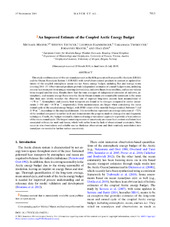| dc.contributor.author | Mayer, Michael | |
| dc.contributor.author | Tietsche, Steffen | |
| dc.contributor.author | Haimberger, Leo | |
| dc.contributor.author | Tsubouchi, Takamasa | |
| dc.contributor.author | Mayer, Johannes | |
| dc.contributor.author | Zuo, Hao | |
| dc.date.accessioned | 2020-06-04T11:17:05Z | |
| dc.date.available | 2020-06-04T11:17:05Z | |
| dc.date.issued | 2019 | |
| dc.Published | Mayer M, Tietsche S, Haimberger L, Tsubouchi T, Mayer, Zuo H. An Improved Estimate of the Coupled Arctic Energy Budget . Journal of Climate. 2019;32(22):7915-7934 | eng |
| dc.identifier.issn | 1520-0442 | en_US |
| dc.identifier.issn | 0894-8755 | en_US |
| dc.identifier.uri | https://hdl.handle.net/1956/22459 | |
| dc.description.abstract | This study combines state-of-the-art reanalyses such as the fifth-generation European Re-Analysis (ERA5) and the Ocean Reanalysis System 5 (ORAS5) with novel observational products to present an updated estimate of the coupled atmosphere–ocean–sea ice Arctic energy budget, including flux and storage terms covering 2001–17. Observational products provide independent estimates of crucial budget terms, including oceanic heat transport from unique mooring-derived data, radiative fluxes from satellites, and sea ice volume from merged satellite data. Results show that the time averages of independent estimates of radiative, atmospheric, and oceanic energy fluxes into the Arctic Ocean domain are remarkably consistent in the sense that their sum closely matches the observed rate of regional long-term oceanic heat accumulation of ~1 W m−2. Atmospheric and oceanic heat transports are found to be stronger compared to earlier assessments (~100 and ~16 W m−2, respectively). Data inconsistencies are larger when considering the mean annual cycle of the coupled energy budget, with RMS values of the monthly budget residual between 7 and 15 W m−2, depending on the employed datasets. This nevertheless represents an average reduction of ~72% of the residual compared to earlier work and demonstrates the progress made in data quality and diagnostic techniques. Finally, the budget residual is eliminated using a variational approach to provide a best estimate of the mean annual cycle. The largest remaining sources of uncertainty are ocean heat content and latent heat associated with sea ice melt and freeze, which both suffer from the lack of observational constraints. More ocean in situ observations and reliable sea ice thickness observations and their routinely assimilation into reanalyses are needed to further reduce uncertainty. | en_US |
| dc.language.iso | eng | eng |
| dc.publisher | American Meteorological Society | en_US |
| dc.title | An Improved Estimate of the Coupled Arctic Energy Budget | en_US |
| dc.type | Peer reviewed | |
| dc.type | Journal article | |
| dc.date.updated | 2020-02-13T08:55:14Z | |
| dc.description.version | publishedVersion | en_US |
| dc.rights.holder | Copyright 2019 American Meteorological Society. For information regarding reuse of this content and general copyright information, consult the AMS Copyright Policy (www.ametsoc.org/PUBSReuseLicenses). | en_US |
| dc.identifier.doi | https://doi.org/10.1175/jcli-d-19-0233.1 | |
| dc.identifier.cristin | 1781164 | |
| dc.source.journal | Journal of Climate | |
